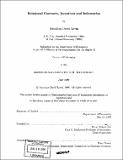| dc.contributor.advisor | Bengt Holmström. | en_US |
| dc.contributor.author | Levin, Jonathan David, 1972- | en_US |
| dc.contributor.other | Massachusetts Institute of Technology. Dept. of Economics. | en_US |
| dc.date.accessioned | 2005-08-22T19:00:24Z | |
| dc.date.available | 2005-08-22T19:00:24Z | |
| dc.date.copyright | 1999 | en_US |
| dc.date.issued | 1999 | en_US |
| dc.identifier.uri | http://hdl.handle.net/1721.1/9520 | |
| dc.description | Thesis (Ph.D.)--Massachusetts Institute of Technology, Dept. of Economics, c1999. | en_US |
| dc.description | Includes bibliographical references. | en_US |
| dc.description.abstract | Chapter 1: I study the design and functioning of self-enforcing incentive contracts under imperfect observability, using a model of repeated agency that allows for both common and private performance monitoring. When performance measures are mutually observed, optimal relational agreements always keep the parties on the Pareto frontier. When performance measures are privately observed, self-enforcing agreements involve the possibility of separation on the equilibrium path, but optimal contracts still take a basic "termination" form. Using these results, one can view optimal long-term contracts as the solution to a static optimization problem. I use this static program to describe the shape of optimal contracts and the nature of second-best inefficiencies. Under standard conditions, optimal moral hazard contracts are "one-step" - a fixed discretionary transfer is made to the agent any time performance is above some cut-off. Hidden information contracts are also characterized and it is shown that optimal contracts call for effort distortion by all types. Chapter 2: This chapter considers self-enforcing relational contracts between a firm and many agents. Even when contracting opportunities are technologically independent, firms will benefit from reaching multilateral contracts that link their transactional arrangements. Optimal multilateral contracts equalize the shadow cost of incentive constraints on each relationship, something bilateral contracts will generally fail to do. I derive some novel implications for asset ownership and ex ante investment, and consider ways in which firms might be able to use existing relationships as "leverage" in reaching new agreements. I also investigate conditions under which firms might want to refrain from multilateral contracting and conduct relationships separately - this may be the case if firm is concerned about a breakdown in one relationship acting as a catalyst that brings down others. The results are applied to discuss two-tier workforce arrangements, supplier associations and the prevalence of diversified business groups in developing countries. Chapter 3: A seminal theorem due to Blackwell (1951) shows that every Bayesian decision-maker prefers an informative signal Y to another signal X if and only if Y is statistically sufficient for X. Sufficiency is an unduly strong requirement in most economic!'problems because it does not incorporate any structure the model might impose. This chapter develops a general theory of information that allows a characterization of the information preferences of decision-makers based on how their marginal returns to acting vary with the underlying (unknown) state of the world. The analysis focuses on "monotone decision problems," in which all decision-makers in the relevant class choose higher actions when higher values of the signal are realized. This restriction allows a characterization of information preferences in terms of stochastic dominance orders over distributions of posterior beliefs. Conditions are also given under which one decision-maker has a higher marginal value of information than another decision-maker, and thus will acquire more information. The results are applied to oligopoly models, labor markets with adverse selection, hiring problems, and a coordination game. (This chapter is co-authored with Susan Athey.) Chapter 4: This chapter revisits Akerlof's classic adverse selection market and asks the following question: do greater information asymmetries reduce the gains from trade? Perhaps surprisingly, the answer is no. Greater asymmetries worsen the "buyer's curse," thus lowering the demand curve, but may shift the supply curve as well. Whether trade increases or decreases depends on where the information impacts the market. A characterization is given for the case of partition information and then for the general case using a definition of information formulated in the previous chapter. | en_US |
| dc.description.statementofresponsibility | by Jonathan David Levin. | en_US |
| dc.format.extent | 133 p. leaves | en_US |
| dc.format.extent | 12654393 bytes | |
| dc.format.extent | 12654153 bytes | |
| dc.format.mimetype | application/pdf | |
| dc.format.mimetype | application/pdf | |
| dc.language.iso | eng | en_US |
| dc.publisher | Massachusetts Institute of Technology | en_US |
| dc.rights | M.I.T. theses are protected by copyright. They may be viewed from this source for any purpose, but reproduction or distribution in any format is prohibited without written permission. See provided URL for inquiries about permission. | en_US |
| dc.rights.uri | http://dspace.mit.edu/handle/1721.1/7582 | |
| dc.subject | Economics. | en_US |
| dc.title | Relational contracts, incentives and information | en_US |
| dc.type | Thesis | en_US |
| dc.description.degree | Ph.D. | en_US |
| dc.contributor.department | Massachusetts Institute of Technology. Department of Economics | en_US |
| dc.identifier.oclc | 43840193 | en_US |
